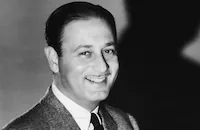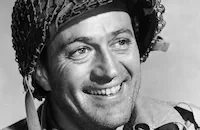Canadian Pacific

Brief Synopsis
Cast & Crew
Edwin L. Marin
Randolph Scott
Jane Wyatt
J. Carroll Naish
Victor Jory
Nancy Olson
Film Details
Technical Specs

Synopsis
In the late 1880's, the development of the Canadian Pacific Railroad is halted by the enormous challenge of finding a route through the Rocky Mountains. At a meeting of the Canadian Parliament, Canadian Pacific general manager William Van Horne reports that surveyor Tom Andrews is in the field attempting to map a route through the mountains. While doing his work, however, Tom is shot at by a fur trader, Dirk Rourke, and his accomplice Cagle. When Tom returns to the railroad construction camp to report to Van Horne, he spots Cagle working there and attacks him. However, Dr. Edith Cabot intervenes and makes Tom aware of her pacifist philosphy, which does not impress him. After he delivers his proposal to Van Horne, Tom heads for Calgary, where his girl friend, Cecille Gautier, is waiting for him on her family's ranch. Rourke has been attempting to court Cecille but she has rejected him. Tom and Cecille's father attend a meeting at Rourke's trading post, where Rourke campaigns against the railroad, saying that it will mean the end of trade in the area. When Tom tries to convince the trappers and farmers that the railroad will bring them many benefits and that Rourke is against it because it will end his business monopoly, he and Rourke become involved in a fistfight, which is broken up by Père Lacombe, whom Cecille has sent. Tom decides to return to the railroad to help to keep peace, prompting Cecille to break their engagement. At the camp, explosives expert Dynamite Dawson tells Tom he suspects Indians of stealing dynamite, and Tom later finds several cases of dynamite buried at an Indian village. The chief apologizes to Tom, saying that some young braves have been paid by a white man to steal the explosives. As Tom unloads the cases back at the camp, Cagle and Rourke shoot at one, causing a large explosion that seriously injures Tom. While on board a train back to the base hospital, Dr. Cabot transfuses her own blood and saves Tom's life. Cecille, meanwhile, overhears Rourke, her father and others plotting to stop the railroad by having the Indians cause trouble and when she objects, her father threatens to disown her. Cecille, who suspects Rourke of having caused the explosion which injured Tom, plans to join Tom at the hospital, but Dynamite persuades her to return home to gather more evidence to pass onto him. A series of explosions, the work of saboteurs, closes down construction on the railroad for the winter. By the spring, Tom has almost fully recovered, and he and Edith are in love. Hearing that there is trouble at the work camp, Tom prepares to return, but Edith persuades him not to wear a gun. Rourke has been stirring up the Indians and has established a saloon and gambling hall at the camp. When a man is shot at the saloon, Edith goes to help but is too late. Tom straps on his guns again and closes down the saloon. Cecille then arrives with the news that Rourke and the Indians are about to attack, and Dynamite rides off to get reinforcements while Tom and the others take refuge in the hospital car. After Cecille's injured father is brought in and tells them that they are considerably outnumbered, Tom goes after Rourke and Cagle and, as the Indians prepare for a final attack, shoots Cagle. Rourke is then killed by a falling tree that had been set on fire as a signal to the Indians. Finally, Van Horne and reinforcements arrive, and the Indians are driven off. Later, however, the Indians walk into the camp and say they want peace. Dismayed by all the violence she has witnessed, Edith heads back East, leaving Tom and Cecille together.

Director

Edwin L. Marin
Cast

Randolph Scott

Jane Wyatt

J. Carroll Naish

Victor Jory

Nancy Olson

Robert Barrat

Walter Sande
Grandon Rhodes

Don Haggerty
John Parrish
Mary Kent

John Hamilton
Howard Negley
Richard Wessel
Pete Kellett
John Dako
Richard Alexander
Rowland Mccracken
Crew
George Archainbaud
Jack Dewitt
Jack Dewitt
Ernst Fegté
Kenneth Gamet
Harold Godsoe
Lee Greenway
Nat Holt
Nat Holt
Harry Howard
Fred Jackman Jr.
Joe Jackman
B. P. Jaques
William Lynch
Philip Martin
William Mcclellan
Leo Mcmahon
Clem Miller
Earl Moser
Alexander Muir
Jacques O'mahoney
Lewis J. Rachmil
Clifford Shank
John Rhodes Sturdy
Dimitri Tiomkin
Rod Tolmie
Lee Vallee
Jim Yarbrough

Videos
Movie Clip



Film Details
Technical Specs

Articles
Canadian Pacific
Randolph Scott stars as Tom Andrews, the buckskin-clad surveyor and "trouble boss," a kind of foreman who has an instinct for spotting troublemakers and intervening in a very physical way before they have a chance to make any trouble. Scott plays Tom as a classic Scott cowboy: ramrod straight, with a big smile, quick fists, and fast draw. He instantly clashes with the railway's new doctor, Edith Cabot (Jane Wyatt), a cultured pacifist who abhors violence, before returning to Cecille (Nancy Olson), the frontier girl he met in the local trapper settlements while searching for the pass. It's a classic dichotomy: the man of the west torn between the wild frontier gal and the civilized society woman. In this pairing, trapper's daughter Olson is the gentler, more romantic of the two, while Wyatt plays the doctor as a fiery, obstinate woman under the corset and severe speeches.
Needless to say, circumstances toss Tom together with Edith while Cecille's people are whipped up into an anti-railway frenzy by the wonderfully-named villain Dirk Rourke (Victor Jory), a fur trader who fears his monopoly on the trading posts will be broken by the railway. Stir in stolen dynamite, Indian tribes on the warpath, and liquor-induced labor unrest, and you've got a war over the rails. Prolific character actor J. Carrol Naish, usually relegated to roles as villains or even Indians, provides color and comic relief as the sourdough Dynamite Dawson, an old coot with a bushy beard who drawls tall tales ("I once won the Kentucky Derby!") as the railway munitions man and Tom's most trusted ally.
If the history is dubious, the majestic landscape is real. Much of Canadian Pacific was shot on location in Banff National Park and Morley Indian Reserve in Alberta and Yoho National Park in British Columbia. Scott's introduction takes place in front of a deep-mountain waterfall that could be a picture postcard. Dense forests fill the screen and mighty mountains in the distance frame the drama. The production was shot in Cinecolor, a budget-minded answer to Technicolor with stronger reds and blues, less dynamic greens (which show in the forest scenes), and softer hues all around, but the color explodes throughout the picture nonetheless.
Randolph Scott and producer Harry Joe Brown formed their own company, Scott-Brown Productions, in 1949. Scott put most of his efforts into his own films for the next decade but continued to make films outside the partnership, including a number for Nat Holt, who left RKO (where he made three solid westerns with Scott) to become an independent producer. Canadian Pacific was the debut feature for Nat Holt Productions and the producer entrusted the project to director Edwin L. Marin, a journeyman who made over 50 films in a twenty-year career, including three earlier films with Scott. The collaboration was successful enough to continue beyond Canadian Pacific. Marin helmed only six more films before his premature death in 1951. Five of those were Scott westerns, including two produced by Nat Holt.
Canadian Pacific delivers familiar western conventions against an impressive backdrop of Canadian locations, giving the film a visual spectacle a little different than most westerns of the era. Such ingenuity does not extend to the portrayal of native tribes, however. The Indians in the film are shown as gullible and childlike at best and savage and treacherous at worst. One scene presents a party of warriors as both sadistic and stupid, and plays their violent deaths for gallows humor. It's quite the old fashioned film, looking back to the simplistic frontier adventures of the past while the industry was starting to mature in the more adult westerns of the 1950s. Like most of Scott's westerns, it was dismissed by the critics and embraced by audiences, turning this into another moneymaker for Scott. When he retired from the screen in 1962, Randolph Scott was one of the richest men in Hollywood.
Producer: Nat Holt
Director: Edwin L. Marin
Screenplay: Jack DeWitt (writer & story); Kenneth Gamet (writer)
Cinematography: Fred Jackman Jr.
Art Direction: Ernst Fegté
Music: Dimitri Tiomkin
Film Editing: Philip Martin
Cast: Randolph Scott (Tom Andrews), Jane Wyatt (Dr. Edith Cabot), J. Carrol Naish (Dynamite Dawson), Victor Jory (Dirk Rourke), Nancy Olson (Cecille Gautier), Robert Barrat (Cornelius Van Horne), Walter Sande (Mike Brannigan), Grandon Rhodes (Dr. Mason), Don Haggerty (Cagle), John Parrish (Mr. Gautier).
C-95m.
by Sean Axmaker
Sources:
"Randolph Scott: The Gentleman From Virginia," Jefferson Brim Crow III. Windriver, 1987.
"The BFI Companion to the Western," ed. Edward Buscomb. Da Capo, 1988.
"The Encyclopedia of Western Movies," ed. Phil Hardy. Woodbury Press, 1984.

Canadian Pacific
Quotes
Trivia
Notes
Canadian Pacific marked Nat Holt's debut as an independent producer after many years at RKO and was the first of three films he made for release by Twentieth Century-Fox in the late 1940s. All starred Randolph Scott and featured Victor Jory. (For information on the other two, please see entries below for Fighting Man of the Plains and The Cariboo Trail.) A October 3, 1948 New York Times article described Holt's negotiations with the Canadian Pacific Railroad's board of directors and with agencies of the Canadian government: "Months of negotiations were required to work out details of customs, immigration, currency exchange and the like connected with the location work in Canada-so much so that the Canadian Government asked that a formal record be made of every step as a model for future projects....The CPR furnished construction gangs who doubled as actors to set up a stretch of dummy track beside the main line; and an authentic old-time construction train..."
A press release from Nat Holt Productions contains the following production information: The film was shot in Banff, Lake Louise, Kicking Horse Pass, the Yoho Valley and on the Morley Indian Reserve near Calgary. Holt employed Indians from the Yiskabee, or Stony tribe, related to the the Sioux tribe, to portray their forefathers. A November 1948 American Cinematographer article reported that Canadian Pacific was the first Cinecolor film to use a post-exposure "flashing" technique which enabled interior scenes to be shot with less light. Although actress Nancy Olson had just been put under contract by Paramount, she made her motion picture debut, on loan-out, in Canadian Pacific. In the film's onscreen cast list, the character portrayed by Robert Barrat is called "Cornelius Van Horne," but in the film he is referred to as "William Van Horne."














